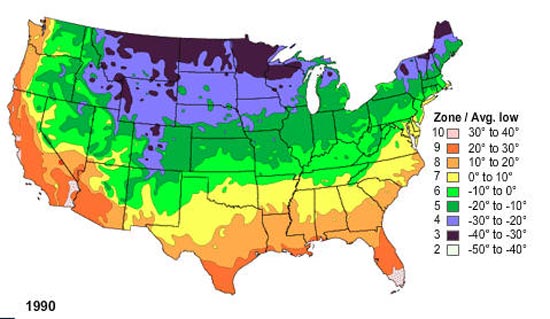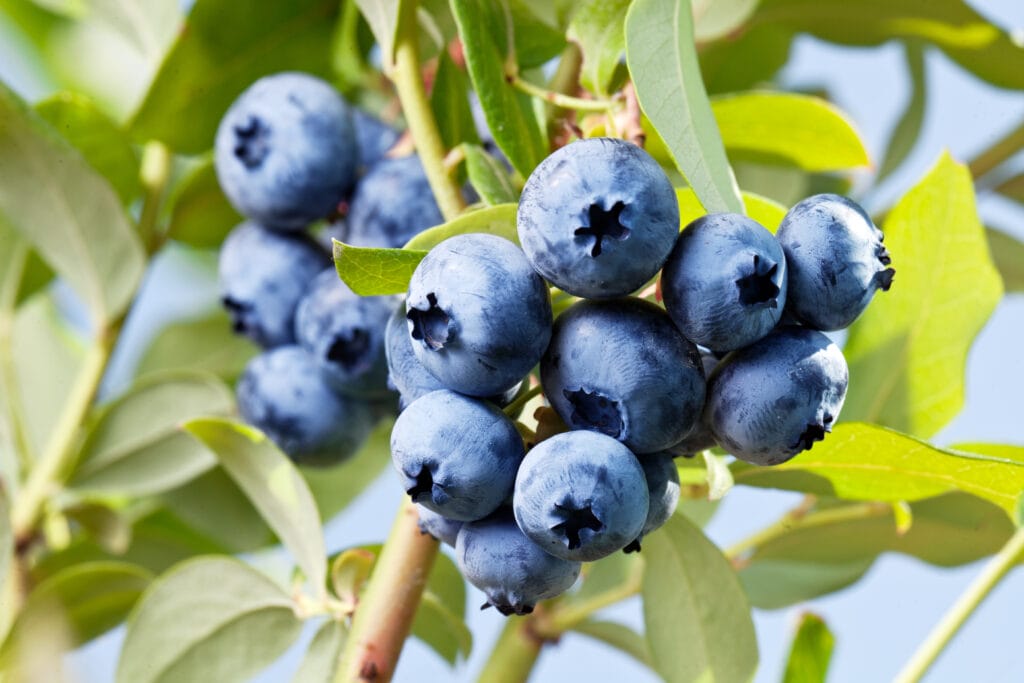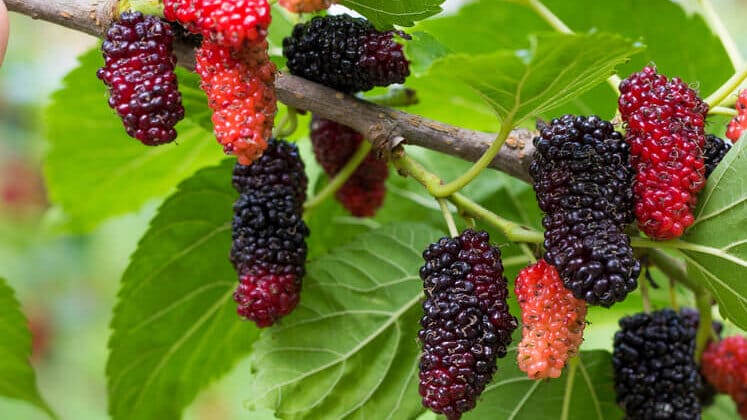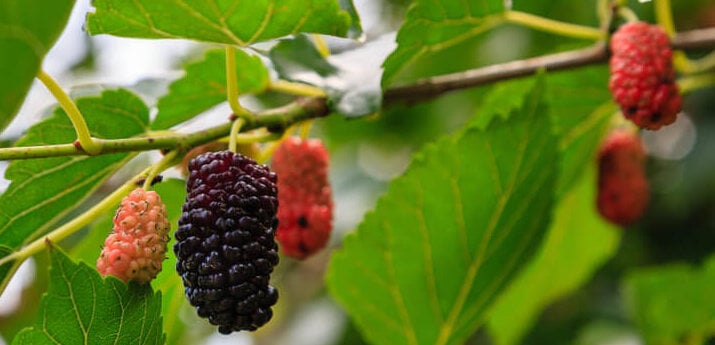What are the Best Berries to Grow in Wisconsin?
Finding the best berries to grow in Wisconsin was not as easy as I thought. Some require extensive care, others are prone to pests, and lots are just not simple & quick enough to grow.
That’s why I created a list of the 10 Best Berries to Grow in Wisconsin!
This ultimate guide will give you the best berries to grow, why you should grow them, and even how to grow them.
Read THIS Before Growing Berries in Wisconsin
Knowing what hardiness zone Wisconsin is in is critical to understanding the best berries that can be grown.
It can be the difference between your berries thriving and providing a bountiful yield or producing nothing and maybe even dying.
Wisconsin is mostly considered Hardiness Zone 5, while some of the lower-level regions are Hardiness Zone 6.

10 Best Berries to Grow in Wisconsin
#1. Blueberries

Popular Varieties: Bluecrop, Bluejay, Duke, Pink Icing
Why Grow Blueberries in Wisconsin?

Cold Hardy:
- Apple Treeslueberry bushes thrive in Wisconsin’s cold spring and cooler fall months. Unlike other fruits, flowers and berries can grow even when there is snow or frost late into the spring.
Fast-Growing:
- Blueberries may be one of the quickest berry bushes to grow. With just a little peat moss and fertilizer you can expect your bush to grow to 6 feet tall in just several years and bare more berries than you know what to do with.
Perfect for ANY Yard:
- Blueberries are perfect for any gardener’s yard. If you have a lot of space you can plant numerous blueberry bushes. If you have a little space you can plant smaller types. And regardless of the climate or soil in Wisconsin, you can plant them just about anywhere in your yard that receives full sun, you just may need to add peat moss for a better yield!
Heavy Harvest:
- Out of all the berries on this list, blueberries have one of the heaviest harvests. Between late June through August, you can pick more blueberries than you’ll be able to eat.
THESE Could Harm Your Blueberries
Pests:
- Deer, Rabbits, & Birds LOVE berries. If left unprotected these pests will eat your fruit before it can even fully grow.
Wet Conditions:
- Too much water can harm and even destroy your blueberry bushes. This is why you should plant it in a well-draining and full-sun area in your yard. Apply thick mulching to protect your plant even more.
Related: Best Mulches for Your Garden
Disease:
- Blueberry bushes are prone to disease. Mold and root rot are just two of the diseases that can attack, harm, and sometimes kill your blueberry bushes in the winter and spring.
Additional Resources
Learn How To Grow Blueberries HERE
#2. Blackberries

Popular Varieties: Triple Crown, Black Diamond, Arapaho
Why Grow Blackberries in Wisconsin?

Cold Hardy:
- Blackberries are another type of berry plant that is cold-hardy in Wisconsin. Blackberries are a perfect complement to blueberries and raspberries, blooming mid-summer to early fall.
Heat-Resistant:
- Blackberries are not only a great plant that is cold-hardy but also do amazing in droughts, high heat, and humidity. This makes it perfect to plant anywhere in your yard, regardless of the amount of sunlight it receives.
Easy to Grow:
- Berries are not always the easiest plant to grow for beginners in Wisconsin. Blackberries though are incredibly easy. They don’t need much care, can grow in any type of soil, and yields a large harvest with little work.
THESE Could Harm Your Blackberries
Deers and Birds
- Like many other berries, deer and birds will eat the flowers of your blackberry bush and even the berries themselves if not properly protected.
Wet Conditions
- While blackberry bushes do great in heat and cold, they can struggle with wet conditions. If the ground becomes too wet over winter and spring then there is a chance that root rot will happen, harming or killing your tree.
Additional Resources
Did you know that blackberry bushes are actually vines that can quickly spread and are considered great border plants for your yard?
#3. Raspberries

Popular Varieties: Anne, Caroline, Tulameen
Why Grow Raspberries in Wisconsin?

Thrives in Heat:
- Raspberries love the heat. The hotter the beat. This makes this berry plant perfect for anywhere in Wisconsin. And even better is that it requires little water, which means more time to spend on your other plants.
Large Yields:
- If you want a large yield of berries for a small plant then look no further than raspberries. One plant can yield an entire summer’s worth of edible raspberries. This makes raspberries the perfect berry plant for gardeners to grow.
Perfect for Small Spaces:
- Blackberries and blueberries can grow quite large. If you don’t have a big backyard this can pose a problem. But you don’t have to worry about this with raspberries and some types only grow 2 feet tall and 2 feet wide!
THESE Could Harm Your Raspberries
Insects:
- Raspberries are the most insect-prone type of berry plant you can grow. Many insects can attack them, but the most dangerous are aphids and caterpillars. Make sure to apply the proper pesticide to protect your raspberries or they will die, as quickly as a day.
Related: Best Insecticides for Your Garden
Wet Conditions:
- Like the other berries on this list, raspberries don’t do well in wet conditions. It is recommended to plant this type of tree in an area of your yard with well-draining soil and long periods of direct sunlight.
Additional Resources
If you want to have the most likelihood of success growing Raspberries it is recommended to prune, apply pesticide, and plant your raspberry plant with peat moss!
#4. Strawberries

Popular Varieties: Royal Sovereign, Albion, Rosie
Why Grow Strawberries in Wisconsin?

Thrives in the heat:
- The hotter, the better. While other berries and fruit plants tolerate heat, strawberries will actually do better the hotter it gets. That means the hot and humid summers are perfect for strawberries bearing more fruit.
Great for Vertical Gardening & Gardening Pots:
- Most berries grow high and wide, but very few just grow high. Strawberries are the only type of berry that can grow in a gardening pot, but also in a vertical garden.
Quick Growing:
- Out of all the berries on this list, strawberries are the quickest growing berry. Not only this, but most Strawberries will actually bear fruit the year they are planted.
THESE Could Harm Your Strawberries
Cold:
- Strawberries do not tolerate cold weather well. While some varieties can survive Wisconsin’s cold weather, most will die if the winter temperatures drop consistently below 10 degrees Fahrenheit. You should always layer hay, leaves, or burlap over them in the winter.
Diseases:
- Strawberries are more prone to diseases than other berries. Root rot is a typical disease that can destroy them, along with other types of mold and fungus. To help minimize the chances of these diseases it is recommended you plant your strawberries in a well-draining, full-sun area of your fruit garden.
Additional Resources
When planting strawberries you should always protect them with fencing or bird net to protect the flowers and berries from birds, chipmunks, and squirrels.
#5. Gooseberries

Popular Varieties: Pixwell, Poorman, Hinnonmaki Red
Why Gooseberries in Wisconsin?

Require Little Room:
- Gooseberries are another type of fruit that requires little space. While they grow 3 to 5 feet tall, they do not spread as wide or become as invasive as other berry plants making them perfect for suburban and urban gardens.
Easy to Grow:
- Once you plant your gooseberry there is nothing else you need to do. You don’t have to worry about heat, cold, water, or many pests. All you need to do is protect it against diseases, fungus, and mold!
THESE Could Harm Your Gooseberries
Diseases:
- Gooseberry plants are another plant that can become prone to disease. Powdery mildew, root rot, and other types of fungus can quickly become a problem if you do not become proactive by applying pesticides.
Drought:
- Gooseberries don’t require much maintenance, but they do require a little bit of water. If you get the summer drought that sometimes happens in Wisconsin, make sure to properly water your gooseberries several times a week.
Additional Resources
Did you know that in some states growing gooseberries is illegal? The reason is that they can carry a disease called white pine blister rust that can quickly spread and kill other trees.
#6. Black Currant

Popular Varieties: Ben Hope, Ben Connan, Ben Lomond
Why Grow Black Currants in Wisconsin?

Thrives in the heat & cold:
- Black Currants are another cold-hardy berry. But did you know that some varieties can be grown in cold weather and some can be grown in warmer weather?
Lots & Lots of Harvest:
- Black Currants produce one of the largest harvests out of all the berries on this list. While black currants aren’t as popular as other berries they can sometimes yield up to 10-15 pounds of fruit in a season.
Amazing Pollinator Attractor:
- If you want berries that attract pollinators like birds, bees, and butterflies then look no further than black currants. Not only this, but black currants are a great cross-pollinator for other fruit trees and plants.
THESE Could Harm Your Black Currants
Insects:
- Insects like the currant worm love black currants. They will not only destroy leaves, but also the plants themselves.
Lack of Nitrogen:
- Unlike other berries that are incredibly hardy, black currants need good soil to prosper. If there is a lack of nitrogen in your soil and it isn’t well-draining expect leaves to turn yellow and your plant to ultimately die.
Additional Resources
Did you know that black currants have many uses, including being used in mead and even some types of beer and wine?
#7. Elderberries

Popular Varieties: American, European
Why Grow Elderberries in Wisconsin?

Loves heat:
- Like other berries, love the elderberries love the heat. They grow bigger and produce more berries the hotter it is.
Perfect for Borders:
- Elderberries grow large and wide. You can expect them to grow 6 to 8 feet tall by 6 to 8 feet wide. This makes it perfect for borders and privacy.
Quick Growing:
- Like blueberries, elderberries grow incredibly fast. Even within the first year or two, elderberries can grow 4 to 6 feet tall and even grow berries.
THESE Could Harm Your Elderberries
Too Much Water
- Elderberries love the heat. But they don’t love too much water. Expect elderberries to get root rot, potentially harm, and even die if they receive too much water.
Birds
- Birds love elderberries. The more elderberry fruit and the more flowers the more birds you can expect. They’ll quickly eat and destroy your plants in one quick feeding.
Additional Resources
Did you know that Elderberries are one of the much beneficial berries for your immune system. While you shouldn’t eat them raw, you can make syrup out of them and it is considered one of the best sources of vitamin C.
#8. Cranberries

Popular Varieties: Ben Lear, Bergman, Baily Compact
Why Grow Cranberries in Wisconsin?

Thrives with Water:
- Cranberry plants are one of the few berries that thrive in water. The more water the better. As a rule of thumb, a cranberry plant will need approximately 1 inch of water a week to let the plant grow and bear fruit.
Great for Small Yards:
- Certain types of cranberry bushes won’t grow tall or wide. Expect them only to grow 1 foot tall making them perfect for gardening pots, urban gardens, and suburban gardens.
THESE Could Harm Your Cranberries
Mold:
- With lots of water comes lots of mold and fungus. Make sure your cranberry bush is planted in a well-draining, full-sun part of your yard, or expect mold and fungus to harm or even kill your berry plant.
Additional Resources
Did you know that cranberries are one of the best berries to help improve kidney health and functionality due to the vitamin k and oxalate that it contains?
#9. Mulberries

Popular Varieties: Black, White, Red
Why Grow Mulberries in Wisconsin?

Thrives in Almost Any Condition:
- While you may not be very familiar with the Mulberry Tree, it is an excellent choice to grow in almost any condition. You can plant it with other trees, by itself in a field, among weeds, or even in a garden and it will quickly grow and bear fruit.
Small Yards:
- The mulberry tree is so versatile because of its size that you can plant it anywhere. Whether it’s in a small space next to your house, in the corner of your garden, or even in a gardening container, the mulberry tree is perfect for all fruit tree growers.
THESE Could Harm Your Mulberry Trees
Garden Pests:
- When growing mulberry trees you will need to protect them from birds. While birds won’t harm the tree itself they have been known to quickly devour the fruit before they even ripen.
Additional Resources
Mulberry trees will grow plenty of fruit by themselves, but to have four to five times the amount of mulberries you should plant them next to another type of mulberry tree to promote cross-pollination.
#10. Boysenberries

Popular Varieties: Thornless, Thorny
Why Grow Boysenberries in Wisconsin?

Loves Heat:
- Out of all the berries on this list, boysenberries thrive the most in heat. This is because they naturally have grown in warmer weather climates. And best of all is that you need to water or care for them very little to have success.
Perfect for Borders:
- Boysenberries are another good plant for borders. When planted correctly you can add borders and privacy to your yard while having plenty of fruit.
THESE Could Harm Your Boysenberries
Cold:
While Boysenberries thrive in a cooler climate, they do need a little bit of protection in winter. To properly protect your boysenberry bush it is recommended that you wrap them in burlap!
Additional Resources
Did you know Boysenberries are unknown to most gardeners but are also some of the most nutritious berries on the planet?
Common Growing Factors of Wisconsin’s Best Berries

As a reminder, the below factors are common for the Best Berries to Grow in Wisconsin:
- Thrives in Heat & Drought
- Thrives in Cold
- Can Grow Anywhere in your yard
- Hardy against Pests & Insects
- Require little maintenance
- Bear heavy fruit
